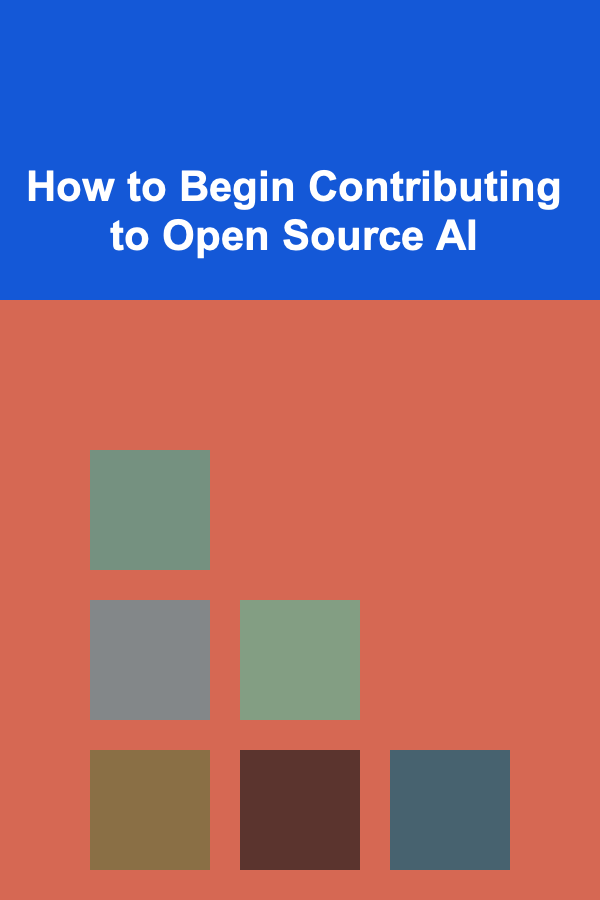
How to Begin Contributing to Open Source AI
ebook include PDF & Audio bundle (Micro Guide)
$12.99$7.99
Limited Time Offer! Order within the next:

Contributing to open-source projects is one of the most impactful ways to give back to the software community, collaborate with experts from around the world, and further your knowledge and skills in a given field. Open-source artificial intelligence (AI) has gained immense popularity in recent years, largely due to the rapid advancements in AI technologies and the widespread application of machine learning (ML), natural language processing (NLP), computer vision, and other AI subfields. If you're interested in AI and want to contribute to this vibrant and transformative space, it's essential to understand the ins and outs of open-source AI contributions.
This guide will help you understand how to begin contributing to open-source AI projects, focusing on the technical, cultural, and community aspects of such contributions. By the end of this article, you will have a roadmap to get started, a list of tools and resources, and insights into how to work effectively in open-source AI.
What is Open Source AI?
Open-source AI refers to AI software and algorithms whose source code is made publicly available, typically under an open-source license. Open-source projects allow anyone to contribute, use, modify, and distribute the software for free. In the context of AI, this could involve machine learning libraries, neural network architectures, tools for data preprocessing, and even large-scale datasets used to train AI models.
Some of the most popular open-source AI projects include:
- TensorFlow: A deep learning framework developed by Google.
- PyTorch: An open-source machine learning library developed by Facebook's AI Research lab.
- Hugging Face: A leading company in NLP offering open-source transformers.
- OpenAI Gym: A toolkit for developing and comparing reinforcement learning algorithms.
- Scikit-learn: A Python library for machine learning that provides simple tools for data mining and analysis.
These projects are widely used by researchers, developers, and companies to advance AI research, develop innovative applications, and solve real-world problems.
Why Contribute to Open Source AI?
There are several compelling reasons to contribute to open-source AI, both personally and professionally:
1. Learning and Skill Development
Contributing to open-source AI allows you to gain hands-on experience with cutting-edge AI technologies, frameworks, and libraries. It provides an opportunity to deepen your understanding of machine learning algorithms, model optimization, data handling, and more. You'll learn from the codebase of experienced developers, improving your technical proficiency.
2. Collaboration with a Global Community
Open-source AI projects typically have contributors from around the world, including experts, researchers, and enthusiasts. By contributing to these projects, you can engage with this global community, exchange knowledge, and work on challenging, high-impact problems.
3. Building Your Portfolio
If you're looking to build your portfolio, open-source contributions are a great way to showcase your skills and demonstrate your ability to solve real-world problems. Employers often look for contributions to well-known open-source projects as an indication of a candidate's expertise and commitment to the field.
4. Advancing the Field
Open-source AI contributions help accelerate the pace of innovation in AI. Whether you're fixing bugs, adding new features, or improving documentation, every contribution helps to enhance the overall quality and usability of AI tools. Your work may empower researchers, developers, and companies to create better AI models and applications.
5. Career Opportunities
Contributing to open-source AI projects is a great way to get noticed by potential employers, collaborators, and the AI community. Many top companies in the AI industry, including Google, Facebook, Microsoft, and others, actively engage with open-source projects and appreciate contributions to the community.
Getting Started with Open Source AI Contributions
Contributing to open-source AI can be a fulfilling and rewarding experience, but it can also feel overwhelming at first. Here is a structured approach to help you get started.
1. Choose Your Area of Interest
AI is a vast field with many different subfields. Before diving into open-source contributions, it's helpful to narrow your focus to a specific area that interests you. Some potential areas to explore include:
- Machine Learning: Contributing to libraries such as TensorFlow, PyTorch, or Scikit-learn.
- Natural Language Processing (NLP): Working with projects like Hugging Face, SpaCy, or AllenNLP.
- Computer Vision: Contributing to projects like OpenCV, Detectron2, or YOLO.
- Reinforcement Learning: Contributing to environments like OpenAI Gym or Stable Baselines.
- AI Ethics and Fairness: Working on projects that focus on responsible AI development, such as Fairness Indicators or AI Explainability 360.
Focusing on an area that excites you will help you stay motivated and increase your chances of making meaningful contributions.
2. Familiarize Yourself with Git and GitHub
Open-source projects are usually hosted on GitHub, a platform for version control and collaboration. GitHub allows you to track changes to code, manage issues, and submit contributions through pull requests.
To begin contributing, you'll need to:
- Learn how to use Git to clone repositories, create branches, and commit changes.
- Understand the workflow of pull requests, which are the mechanisms by which you contribute code to a project.
- Use GitHub Issues to find bugs or tasks that need to be fixed or developed.
- Participate in discussions, where you can ask questions and discuss ideas with other contributors.
There are many tutorials available online to learn Git and GitHub, including GitHub's own guides and resources like the "Pro Git" book.
3. Find Open-Source AI Projects to Contribute To
There are many open-source AI projects on GitHub, but finding the right one to contribute to can be tricky. Here are some tips to help you identify suitable projects:
- Look for popular projects: Popular open-source AI libraries like TensorFlow, PyTorch, and Hugging Face often have extensive documentation and an active community of contributors. They also provide labels like "good first issue" or "help wanted" for newcomers.
- Explore your favorite tools: If you're already familiar with a particular AI library or framework, search for open issues or contributions that align with your expertise.
- Check out repositories with active maintainers: A good open-source project has an active maintainer or team of maintainers who regularly update the codebase, manage issues, and review pull requests.
- Search for projects tagged with "AI" or "Machine Learning": GitHub repositories often have tags or labels like "AI", "Machine Learning", or "NLP". You can search for these tags to find relevant projects.
4. Contribute to Documentation, Tutorials, or Issues First
If you're new to open-source contributions, you may want to start by contributing to non-code aspects of the project. This could include:
- Improving documentation: Many open-source AI projects lack clear or comprehensive documentation. By contributing to documentation, you make the project more accessible to other users and developers.
- Writing tutorials: Create tutorials or guides for new users to help them get started with the AI library or tool.
- Reporting bugs or issues: If you come across any bugs or challenges while using the library, report them via GitHub issues. Provide clear, detailed information to help the maintainers address the issue.
These types of contributions can provide a low-barrier entry to open-source AI while giving you insight into the project's structure and workflows.
5. Start Coding and Submit Pull Requests
Once you're comfortable with the project and have identified a task or issue to tackle, you can begin coding. Follow these steps:
- Fork the repository: This creates a personal copy of the project on GitHub where you can make changes.
- Clone your fork: Download the repository to your local machine using Git.
- Create a new branch: Always create a new branch when making changes. This keeps your work isolated and makes it easier to manage.
- Make your changes: Implement your changes, fix bugs, or add features.
- Test your changes: Ensure that your changes work correctly and don't introduce any new issues.
- Commit and push: Commit your changes to your branch and push them to GitHub.
- Create a pull request: Once your changes are ready, open a pull request to merge them into the main project.
6. Engage with the Community
One of the key benefits of contributing to open-source AI is the opportunity to engage with a passionate and knowledgeable community. As you contribute, make sure to:
- Ask questions: If you're unsure about something, ask for help. Open-source communities are generally welcoming to newcomers.
- Be responsive: If someone provides feedback on your pull request, be sure to respond promptly and address any concerns.
- Give feedback: If you review someone else's pull request, be constructive and thoughtful in your comments.
- Join discussions: Participate in the discussions around issues, new features, and improvements. This will help you build relationships with other contributors.
7. Keep Learning and Expanding Your Skills
Open-source AI projects are constantly evolving, and there are always new technologies, tools, and techniques to learn. Stay up-to-date by:
- Following AI conferences, workshops, and webinars.
- Reading AI research papers to deepen your theoretical knowledge.
- Contributing to new AI projects or libraries as they emerge.
- Experimenting with different AI models and algorithms in your personal projects.
8. Be Patient and Persistent
Open-source contributions are a long-term endeavor, and it's important to be patient. Not all pull requests will be merged immediately, and it may take time to get comfortable with the workflows and culture of a new project. Stay persistent, continue contributing, and you will grow as both a developer and an AI enthusiast.
Conclusion
Contributing to open-source AI is a valuable and rewarding experience that can enhance your skills, broaden your professional network, and help you make a meaningful impact in the field of artificial intelligence. By following this guide, you can get started on your journey toward contributing to open-source AI projects, whether through bug fixes, feature development, documentation improvements, or community engagement.
The open-source AI community is vast and diverse, and there are countless opportunities for you to learn, collaborate, and grow. So, take the plunge, pick a project, and start contributing today!

Expert Tips for Bargain Hunting for Furniture and Home Decor
Read More
How to Create a Checklist for Setting Personal Development Goals
Read More
How to Optimize Your Financial Plan for Tax Efficiency
Read More
How to Use Wall Space for Vertical Storage Solutions
Read More
How To Leverage LinkedIn for Your Job Search
Read More
How to Manage Dry Mouth: Strategies for Dental Hygienists
Read MoreOther Products

Expert Tips for Bargain Hunting for Furniture and Home Decor
Read More
How to Create a Checklist for Setting Personal Development Goals
Read More
How to Optimize Your Financial Plan for Tax Efficiency
Read More
How to Use Wall Space for Vertical Storage Solutions
Read More
How To Leverage LinkedIn for Your Job Search
Read More